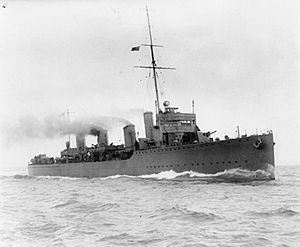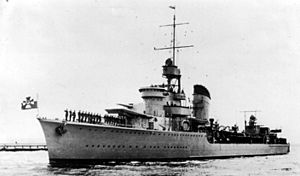J. Samuel White facts for kids
| Private company | |
| Industry | Shipbuilding |
| Founded |
|
| Defunct | 1981 |
| Headquarters | Cowes, Isle of Wight |
J. Samuel White was a well-known British company that built ships, especially for navies. It was based in Cowes on the Isle of Wight. The company was named after John Samuel White (1838–1915), who was a key figure in its history.
This company became very important during the Victorian era. In the 20th century, they built many destroyers and other military ships for the Royal Navy and for other countries. They also built lifeboats and different kinds of ships for businesses.
Contents
A Long History of Building Ships
The White family had been building ships in Kent for a long time. In 1763, James White built a ship called the Lapwing for the Royal Navy. They also built fast ships for customs services and fishing boats.
Thomas White (1773–1859), who was John Samuel White's grandfather, moved the family business from Broadstairs to East Cowes on the Isle of Wight in 1802. He took over a shipbuilding site that already had more than 100 years of history.
During the end of the Napoleonic War, Thomas White started a new shipyard called 'Thetis' Yard in 1815. Later, in 1825, he rebuilt the original site, which became the 'Falcon Yard'.
By the 1850s, J. S. White's shipyards were very busy. They had steam-powered sawmills and workshops for engines, masts, and other parts. About 500 skilled workers were employed there. The company grew even more in 1899.
J. S. White quickly became a world leader in designing and building small to medium-sized ships for navies and businesses. They also built many smaller boats, including over 130 lifeboats for the RNLI (Royal National Lifeboat Institution). This was more than any other builder!
Sir Barnes Wallis, who later became a famous engineer for designing aircraft like the "bouncing bomb" used in World War II, started his career as a draughtsman (someone who draws technical plans) at J. S. White.
In 1911, the shipyard expanded and bought a huge 80-ton hammerhead crane. This crane was installed in 1912 on the Cowes side of the river. It's still there today and is considered a historic landmark!
At its busiest, J. S. White had shipbuilding areas on the east side of the River Medina in East Cowes. On the west side, in Cowes, they had docks for fitting out ships, engineering workshops, and offices.
The company also owned other businesses. In 1922, they started 'Island Transport Co. Ltd.' to carry supplies for their shipyards using barges. Later, this company also carried general goods and was sold in 1968. J. S. White also bought a rope-making business and a shipbuilding company in Scotland.
In 1961, J. S. White even bought a company that printed postcards and greeting cards, called J. Arthur Dixon. This shows how diverse the company had become!
Over time, the Cowes site became more focused on engineering, building turbines, boilers, and different types of engines.
The shipbuilding part of the company closed in 1965. The East Cowes site was sold to the British Hovercraft Corporation in 1966.
In 1968, another company, the Foreign and Colonial Investment Trust, took over J. S. White. At that time, about 1,000 people worked for the group of companies.
Later, in 1971, J. S. White was sold again to Spectrol Holdings. By 1979, the company was renamed Elliott Turbomachinery Ltd. Finally, in 1981, the company stopped trading and closed down.
Between 1803 and 1963, J. S. White built over two thousand vessels at their shipyards!
J. S. White was famous for building powerful naval vessels. In 1911, they received an order for six destroyers for the Chilean Navy. These destroyers used J. S. White's own special design of water-tube boilers.
During World War II, the J. S. White shipyard played a crucial role. For example, in May 1942, the Polish destroyer ORP Błyskawica was being repaired at the shipyard where it had been built. On the night of May 4th, the Luftwaffe (German air force) bombed the area heavily. The Błyskawica bravely fought back all night with its guns, helping to protect Cowes from even worse damage. Despite the bombing, the shipyard was able to continue its vital work.
Here are some of the types of naval vessels built by J. Samuel White:
- Vigilant-class gun vessel (1856)
- HMS TB81, a torpedo boat (1885)
- Conflict-class destroyer (1895)
- River-class destroyer (1905)
- Tribal-class destroyer (1906-1909)
- Acorn-class destroyer (1911)
- Almirante Lynch-class/Faulknor-class flotilla leader (1912-1914) – Some of these were originally for Chile but were used by the Royal Navy during World War I.
- Laforey-class destroyer (1913)
- Admiralty M-class destroyer (1915)
- R-class destroyer (1916)
- S-class destroyer (1917)
- V and W-class destroyer (1917)
- HMS E32 Submarine (1917)
- Mendoza-class destroyer (late 1920s) – built for the Argentine Navy.
- Grom-class destroyer (1937) – built for the Polish Navy, including ORP Grom and ORP Błyskawica. The Błyskawica is now a museum ship in Gdynia, Poland, and is the oldest preserved destroyer in the world!
- J-, K- and N-class destroyer (1939)
- Type I Hunt-class destroyer escort (1939)
- Type II Hunt-class destroyer escort (1939)
- C-class destroyer (1943-1945) – including HMS Cavalier (R73), which is now a museum ship at Chatham Historic Dockyard.
- Daring-class destroyer (1950)
- Blackwood-class frigate (1952-1957)
- Rothesay-class frigate (1961)
- Leander-class frigate (1965) – HMS Arethusa (F38) was the very last ship J. S. White built for the Royal Navy.
Lifeboats for Rescue
J. S. White also built many lifeboats for the Royal National Lifeboat Institution (RNLI) and other groups. These boats were crucial for saving lives at sea.
Some of the lifeboat types they produced include:
- Barnett-class lifeboats
- Liverpool-class lifeboat
- Oakley-class lifeboats
- Watson-class lifeboats
Building Aircraft
In 1912, J. S. White started building aircraft at East Cowes. They called their aircraft division Wight Aircraft.
Between 1912 and 1916, the company moved its aircraft factory to Cowes and built several seaplanes (planes that can take off and land on water):
- Wight Pusher Seaplane
- Wight Twin
- Wight Seaplane
- Wight Baby
- Wight Bomber
- Wight Quadruplane
In 1913, they showed a flying boat at the London Air Show. The company also built 110 Short Type 184 aircraft, which were designed by another company called Short Brothers.
Ships for Everyday Use
J. S. White also built ships for regular businesses and public services. These included:
- Crested Eagle, a paddle steamer built in 1925. It was later used during the Dunkirk evacuation in World War II.
- The Massey Shaw, a fireboat for the River Thames (1935).
- The Woolwich Ferries, John Benn (1930) and Will Crooks (1930).
- The Nore Light Vessel (1931), a floating lighthouse.
- Two Cowes Floating Bridges (1925 & 1936), which are chain ferries.
- The first Sandbanks chain ferry (1926).





